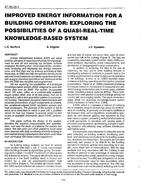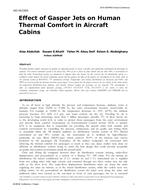Click here to purchase
Indoor environment quality has been researched extensively, with many countries adopting regulations to ensure that building occupants enjoy healthy working environments. In many small island developing states (SIDS), such as Mauritius, the population benefits from perfect weather conditions, but building design considerations often under-estimate the effects of outdoor weather conditions, heat and pollutant emission, illumination and noise, which worsen indoor environment. This study aims at determining the actual indoor environment inside a dyehouse of Mauritius and to propose engineering solutions for better IAQ and thermal comfort. Although Mauritians spend 90% of time indoors, a survey conducted among factory operators reveals 69% of employees having poor understanding of IEQ and 96% being unaware of laws and standards regulating IEQ. 85% of population express dissatisfaction for indoor temperature despite preventive measures already implemented. According to NIOSH heat matrix, 66% and 30% of zones are in “Extreme caution” and “Danger” categories respectively, where employees are likely to experience heat stress, heat exhaustion and muscle cramps. A building load assessment confirmed that manufacturing processes deteriorate IEQ, with internal heat gain between 40%-77% during day shift and reaching 93% during night shift, compared to heat gain from external sources. High concentrations of PM2.5 and PM10 recorded in several zones, lead to alarming air quality index, due to manufacturing processes used and raw materials treated. A mechanical ventilation was therefore designed to enhance IAQ and thermal comfort. Design procedures followed guidelines from ASHRAE Standard 55-2017, ASHRAE Handbook Fundamentals (2001) and Equal-friction method. The ventilation system was split into 12 air supply systems and 11 air return systems, with main components consisted of fans, filters, air inlets, diffusers, ductings and fittings. The textile factory was modeled on ANSYS-Fluent-2020-R2 to evaluate the air distribution patterns, air temperature contours and air velocity contours. The proposed design, with capital investment of 1million USD, offers satisfactory air distribution, reducing rise in air temperature and pollutant level. However, an important decision-making factor for implementing ventilation systems implies balancing price competitiveness versus ethical and environmental compliance.
Citation: IAQ 2020: Indoor Environmental Quality
Product Details
- Published:
- 2020
- Number of Pages:
- 11
- File Size:
- 1 file
- Product Code(s):
- D-IAQ2020-C11
- Note:
- This product is unavailable in Belarus, Russia


